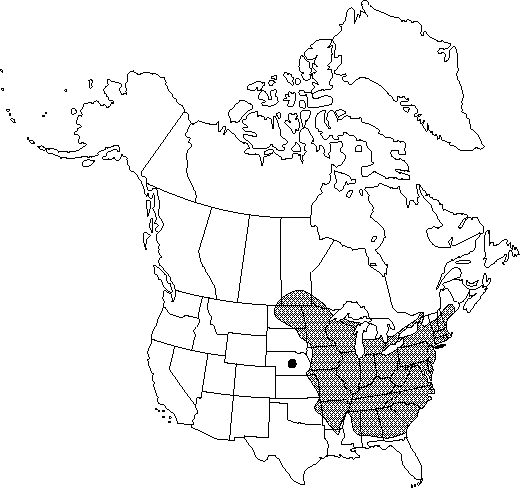Difference between revisions of "Corylus americana"
Fl. Carol., 236. 1788.
FNA>Volume Importer |
FNA>Volume Importer |
||
| Line 33: | Line 33: | ||
}}<!-- | }}<!-- | ||
| − | --><span class="statement" id="st- | + | --><span class="statement" id="st-undefined" data-properties=""><b>Shrubs,</b> open, upright, rounded, to 3(–5) m. <b>Bark</b> light gray, smooth. <b>Branches</b> ascending; twigs pubescent, covered with bristly glandular hairs. <b>Winter</b> buds containing inflorescences broadly ovoid, 3–4 × 3–4 mm, apex obtuse to rounded. <b>Leaves</b>: petiole pubescent, densely glandular-bristly. <b>Leaf</b> blade broadly ovate, often with straight sides and slight lobes near apex, giving them squarish appearance, 5–16 × 4–12 cm, moderately thin, base narrowly cordate to narrowly rounded, margins sharply serrate or obscurely doubly serrate, apex abruptly to long-acuminate; surfaces abaxially sparsely to moderately pubescent, velutinous to tomentose along major veins and in vein axils. <b>Inflorescences</b>: staminate catkins lateral along branchlets on very short shoots, usually in clusters of 1–2, 4–8 × 0.5–0.8 cm; peduncles mostly 1–5 mm. <b>Nuts</b> in clusters of 2–5, sometimes partially visible; bracts much enlarged, leaflike, distinct nearly to base, slightly longer than to 2 times length of nuts, apex deeply and irregularly laciniate; bract surfaces downy-pubescent, abaxially stipitate-glandular. <b>2n</b> = 22, 28.</span><!-- |
-->{{Treatment/Body | -->{{Treatment/Body | ||
| Line 65: | Line 65: | ||
|publication year=1788 | |publication year=1788 | ||
|special status=Endemic;Selected by author to be illustrated | |special status=Endemic;Selected by author to be illustrated | ||
| − | |source xml=https://jpend@bitbucket.org/aafc-mbb/fna- | + | |source xml=https://jpend@bitbucket.org/aafc-mbb/fna-data-curation.git/src/9216fc802291cd3df363fd52122300479582ede7/coarse_grained_fna_xml/V3/V3_231.xml |
|subfamily=Betulaceae subfam. Coryloideae | |subfamily=Betulaceae subfam. Coryloideae | ||
|genus=Corylus | |genus=Corylus | ||
|species=Corylus americana | |species=Corylus americana | ||
| − | |||
| − | |||
| − | |||
| − | |||
| − | |||
| − | |||
| − | |||
| − | |||
| − | |||
| − | |||
| − | |||
| − | |||
| − | |||
| − | |||
| − | |||
| − | |||
| − | |||
| − | |||
| − | |||
| − | |||
| − | |||
| − | |||
| − | |||
| − | |||
| − | |||
| − | |||
| − | |||
| − | |||
| − | |||
| − | |||
| − | |||
| − | |||
| − | |||
| − | |||
| − | |||
| − | |||
}}<!-- | }}<!-- | ||
-->[[Category:Treatment]][[Category:Corylus]] | -->[[Category:Treatment]][[Category:Corylus]] | ||
Revision as of 13:36, 27 July 2019
Shrubs, open, upright, rounded, to 3(–5) m. Bark light gray, smooth. Branches ascending; twigs pubescent, covered with bristly glandular hairs. Winter buds containing inflorescences broadly ovoid, 3–4 × 3–4 mm, apex obtuse to rounded. Leaves: petiole pubescent, densely glandular-bristly. Leaf blade broadly ovate, often with straight sides and slight lobes near apex, giving them squarish appearance, 5–16 × 4–12 cm, moderately thin, base narrowly cordate to narrowly rounded, margins sharply serrate or obscurely doubly serrate, apex abruptly to long-acuminate; surfaces abaxially sparsely to moderately pubescent, velutinous to tomentose along major veins and in vein axils. Inflorescences: staminate catkins lateral along branchlets on very short shoots, usually in clusters of 1–2, 4–8 × 0.5–0.8 cm; peduncles mostly 1–5 mm. Nuts in clusters of 2–5, sometimes partially visible; bracts much enlarged, leaflike, distinct nearly to base, slightly longer than to 2 times length of nuts, apex deeply and irregularly laciniate; bract surfaces downy-pubescent, abaxially stipitate-glandular. 2n = 22, 28.
Phenology: Flowering very early spring.
Habitat: Moist to dry open woods and thickets, hillsides, roadsides, fencerows, and waste places
Elevation: 0–750 m
Distribution

Man., Ont., Sask., Ala., Ark., Conn., Del., D.C., Ga., Ill., Ind., Iowa, Kans., La., Ky., Maine, Md., Mass., Mich., Minn., Miss., Mo., Nebr., N.H., N.J., N.Y., N.C., N.Dak., Ohio, Okla., Pa., R.I., S.C., S.Dak., Tenn., Vt., Va., W.Va., Wis.
Discussion
Corylus americana is a weedy species, sometimes considered a pest in carefully managed forests. The nuts are smaller but of the same general quality and flavor as commercial filberts (Corylus maxima Miller and C. colurna Linnaeus).
Native Americans used Corylus americana medicinally for hives, biliousness, diarrhea, cramps, hay fever, childbirth, hemorrhages, prenatal strength, and teething, to induce vomiting, and to heal cuts (D. E. Moerman 1986).
Selected References
None.
